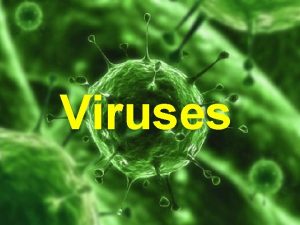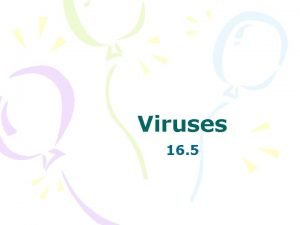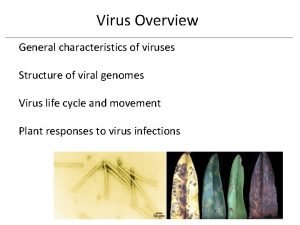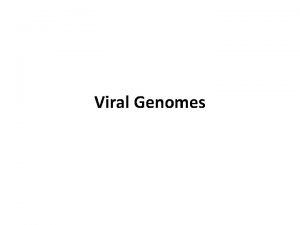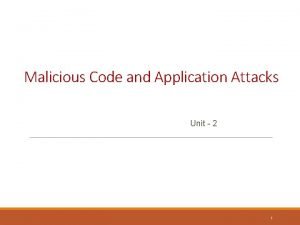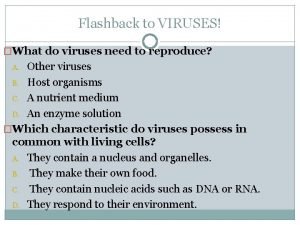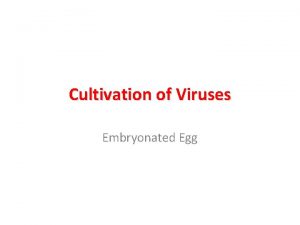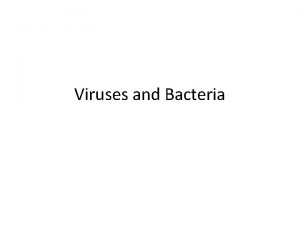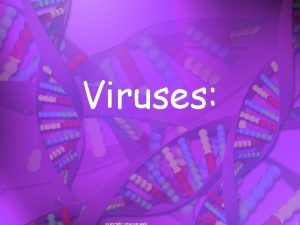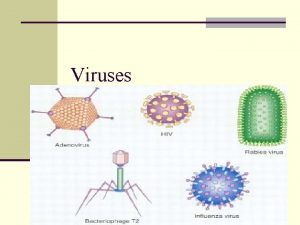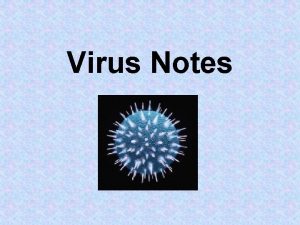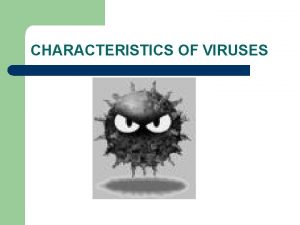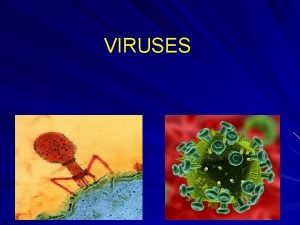Viruses Virus Characteristics Virus a tiny nonliving particle











- Slides: 11

Viruses

Virus Characteristics Virus – a tiny, nonliving particle that enters and reproduces inside a living cell. Viruses can ONLY multiply when inside a living cell. A Virus acts like a parasite!

The Shape of a Viruses Varicella-zoster – the virus that causes Chicken Pox Filovirus – the virus that causes Ebola come in many different shapes. Bacteriophage – A virus that attacks bacteria. Mononegavirales – the virus that causes Rabies

The Size of a Viruses are smaller than cells. Scientists use Electron Microscopes to see them. Viruses are smaller than bacteria. A Cold Virus has a diameter 100 times smaller than that of a Strep Throat Bacteria Virus

Parts of a Virus A Virus has 2 Parts: Protein Coat (protection) Inner Core (holds DNA) Lock-and-Key Action The protein coat’s shape has to fit into specific proteins on the host’s cells. Example: The Cold Virus only infect cells in the nose and throat.

How do Viruses Multiply? Once a virus “fits” into the host cell, the genetic material inside the virus takes over the host cell. When the cell multiplies, then the genetic material of the virus also multiplies. https: //www. youtube. com/watch? v=Rpj 0 em. EGSh. Q

Diseases caused by Viruses Common Cold Influenza (“Flu”) Small Pox Chicken Pox Measles Yellow Fever Ebola HIV/AIDs Shingles Polio Mononucleosis (“Mono”)

Treatment and Prevention Viral diseases cannot be treated with antibiotics like Bacterial diseases. Viral diseases can only be prevented with… Vaccination - Dead or weakened pathogens are deliberately injected into a person’s body to produce antibodies.

Vaccinations When given a vaccination, the weakened virus usually does not make the person sick. The weakened virus allows the person’s immune system to produce antibodies. The antibodies “remember” the virus and they fight the virus off before you get sick. This prevents a person from getting a disease when they are exposed to the virus later.

Decide what causes the diseases and if they should be treated or prevented. Infectious Disease Lyme Disease Polio Measles Strep Throat Influenza (Flu) Caused by Bacteria or Virus? Treat with Antibiotic or Prevent with Vaccination?

Decide what causes the diseases and if they should be treated or prevented. Infectious Disease Caused by Bacteria or Virus? Treat with Antibiotic or Prevent with Vaccination? Lyme Disease Bacteria Treat with Antibiotic Polio Virus Prevent with Vaccination Measles Virus Prevent with Vaccination Strep Throat Bacteria Treat with Antibiotic Influenza (Flu) Virus Prevent with Vaccination
 M7rh5si5154 -site:youtube.com
M7rh5si5154 -site:youtube.com Youtube
Youtube Why are viruses considered nonliving?
Why are viruses considered nonliving? Why are viruses considered nonliving
Why are viruses considered nonliving Nonliving particle that replicates inside a living cell
Nonliving particle that replicates inside a living cell Bacteriophage characteristics
Bacteriophage characteristics General characteristics of viruses
General characteristics of viruses Living and nonliving characteristics
Living and nonliving characteristics Viruses
Viruses Lysogenic viruses do not
Lysogenic viruses do not Section 19-3 diseases caused by bacteria and viruses
Section 19-3 diseases caused by bacteria and viruses Cultivation of viruses
Cultivation of viruses


